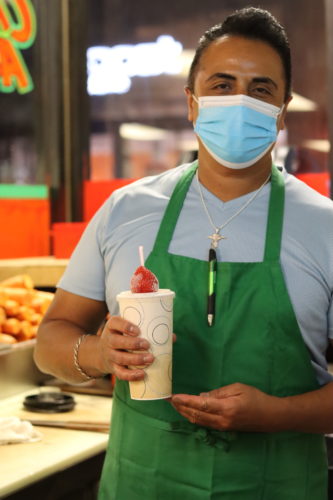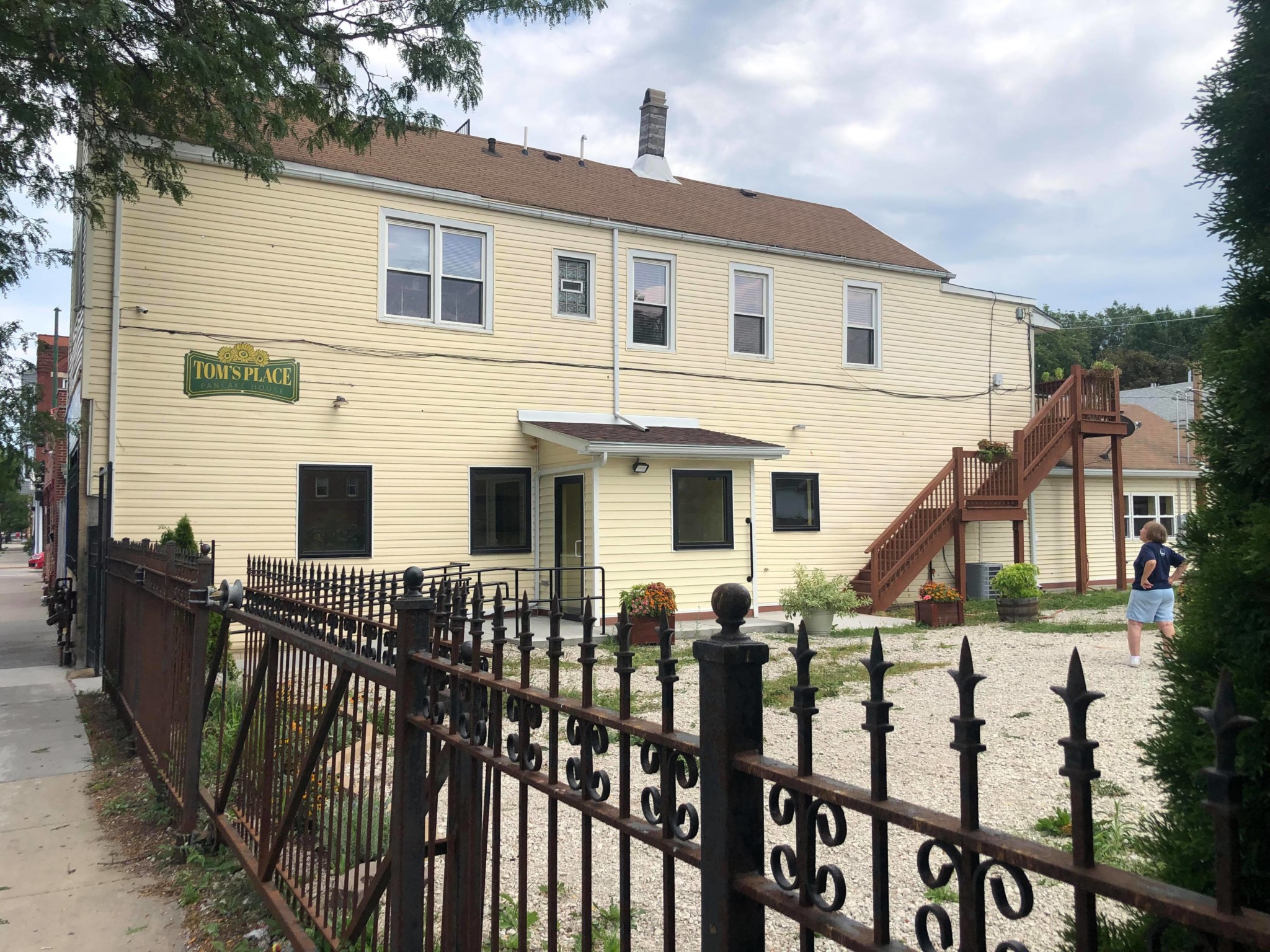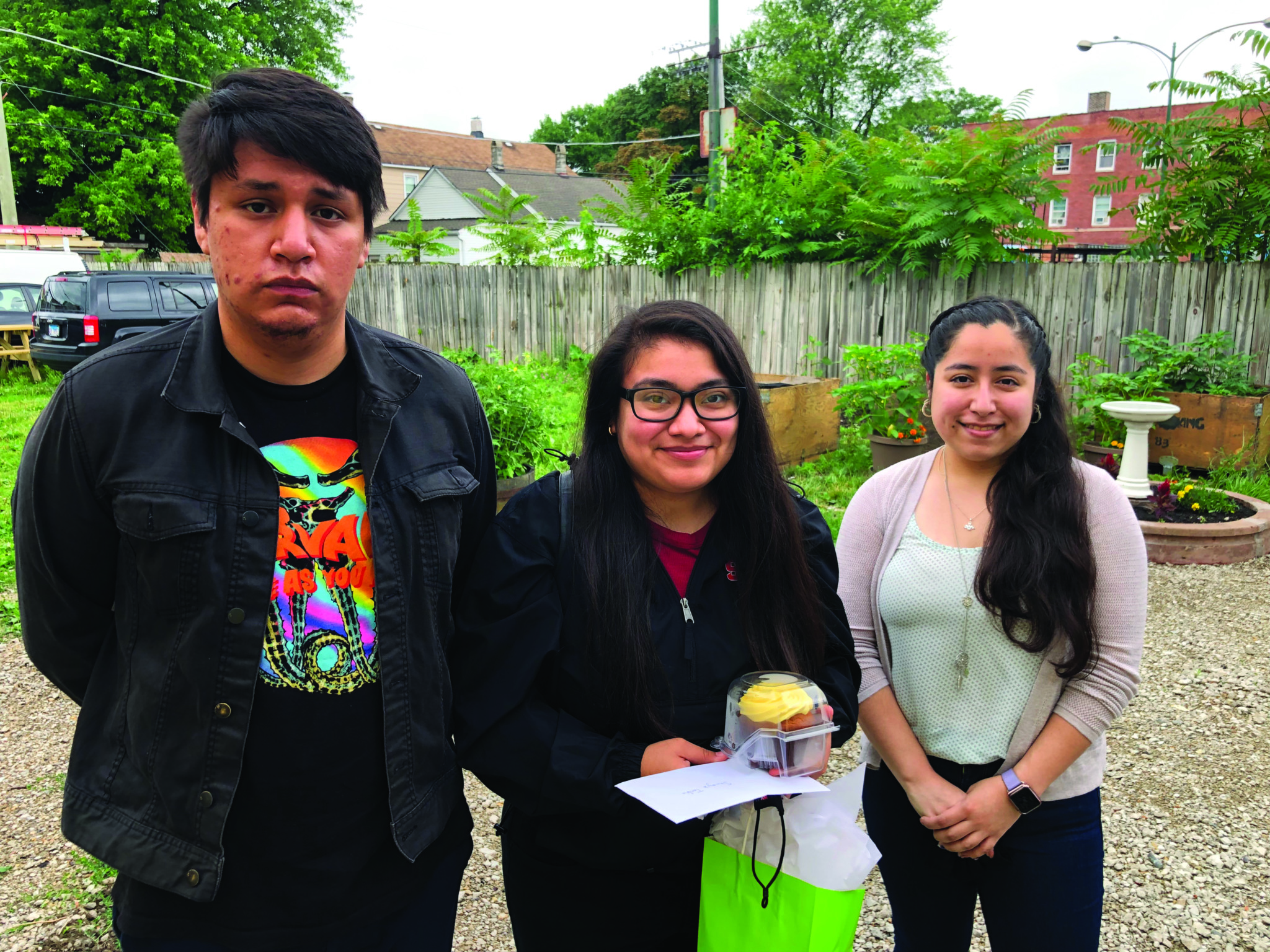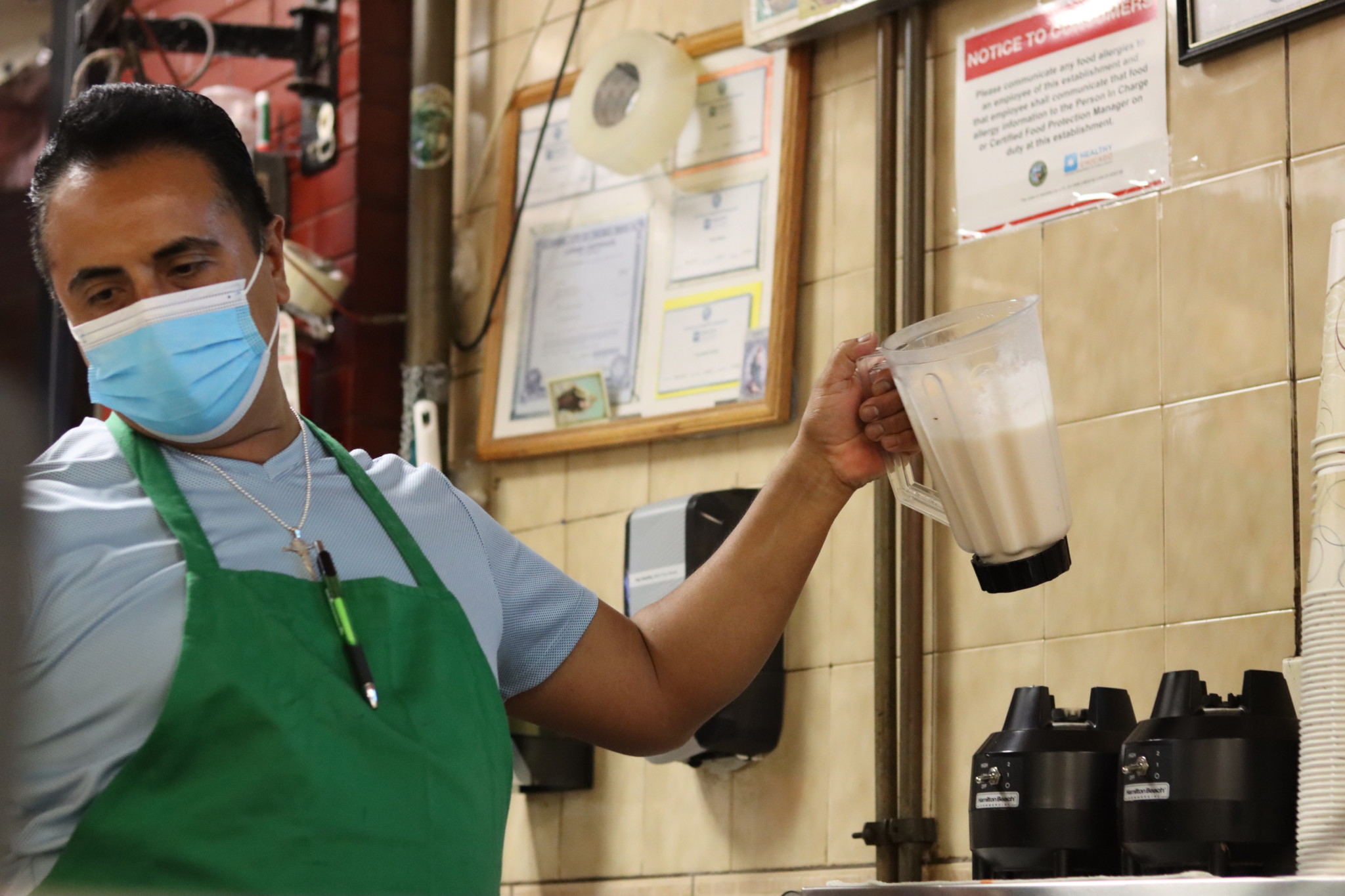- Best Milkshake Maker
- Best Recreational Sports League
- Best Restaurant Soon to Be Open
- Best Pandemic Community Building
What makes Back of the Yards so special? A neighborhood that took its name from where it was built, literally behind the old Union Stockyards; an afterthought meant to house the poor immigrant workers who endured unsafe and unsanitary labor conditions to then come home to more unsafe and unsanitary conditions. Houses built over a former city landfill with small rooms whose purpose was to fit as many workers as possible.
In its heyday, as the slaughterhouse capital of the country, some even referred to the neighborhood as a “smell” depending on what direction the wind blew. A neighborhood that still today is often an afterthought to many of the local politicians (not all). A community that has suffered decades of systemic disinvestment and lacking of sustainable resources.
It’s the people that make the neighborhood. If there’s one common strand that connects the German, Polish, Lithuanian, Slavic, Mexican and Black migrants that have inhabited this area since the mid 1800’s, it’s the grit, the ganas and determination for survival. I mean, how else do you become Upton Sinclair and write The Jungle, which led to the creation of the USDA, or Saul Alinsky, who some consider the father of modern day organizing, or Carmen Velazquez, the founder of Alivio Medical Center? Like them, there are many, past and present who have contributed to the fabric of what is now the Back of the Yards.
My family arrived in January 1979, welcomed by the blizzard that famously cost Mayor Bilandic his reelection, to a part of the neighborhood that was quickly changing from Lithuanian to Mexican. They left the city they loved with a climate in the high 70s to an unknown frontier with twenty-plus inches of snow and sub-zero temperatures. It still amazes me to think what drove them, like many others, to leave behind the life they knew to a future of unknowns.
Like them, there are many untold stories of immigrant plight amongst my neighbors past and present. Some, because they choose to bury the memories because the pain of bringing them up is too much to bear, thers, because their stories are not as valued. But mostly, it’s because the story of our neighborhood is often narrated by outsiders with no firsthand experience or relationships to invest the time.
Not everyone is an Alinsky or a Sinclair, but without the Candelaria and Vicente Iñiguez’s of the world, our local economy wouldn’t be thriving; laborers who bring the pan de cada dia (“the daily bread”) from the neighborhood panaderia and carniceria that employ people from the neighborhood. If it weren’t for them, there wouldn’t be any of us. That is what makes this neighborhood so great.
The neighborhood is changing, but not because of developers, speculators, and politicians. It is changing because of its own people. For the first time, the next generation isn’t leaving in search of upward mobility. We’re staying, building, and challenging the norms. Longstanding institutions like the Back of the Yards Neighborhood Council and the Peace and Education Coalition are coexisting with younger organizations like Increase the Peace and Amor al Arte, all of which were founded by natives.
You also have newer small businesses like the Back of the Yards Coffee Company, which I own, and Tom’s Place, started by community members, co-existing with longstanding businesses like Atotonilcos, El Guero, and La Internacional. Despite the picture that outsiders paint of Back of the Yards, this community is thriving, and it’s thriving because of the people and the time, energy and money we’re investing, filling the gaps where the City, County and State have failed us for so long.
We are organizing, hiring local, and representing the Back of the Yards with pride. These are just some examples of the many jewels that exist here. The people are the Back of the Yards’ best. (Jesse Iñiguez)
Neighborhood co-captain Guadalupe Ceja was captain of Best of Back of the Yards in 2020 and co-captain Jacqueline Serrato is the editor in chief of the Weekly.
Best Milkshake Maker
El Señor de los Licuados

If you’re from Back of the Yards you know who I’m talking about, but you probably don’t know much else. I don’t even have to say from where and you can already picture him, with his flawless 80’s grupero haircut, impeccable mustache, and neatly ironed attire.
I’m talking about the cashier of the Atotonilco’s on 47th that has been here since forever. He is better known as “El [señor] de los licuados” or the licuadoman (the milkshake man). I’ve known him for years, but even I didn’t know his name until recently, even though I chitchat with him every time I’m there. He’s been a neighborhood institution since I can remember. I can’t picture there ever being an Atotonilco’s without him. While the tacos at Atotonilco’s are good and unique themselves (I learned recently that they make their own tortillas from corn grown in the owner’s farm), that’s not what they’re famous for. They’re famous for the chocolate and strawberry licuados, but specifically made by el señor de los licuados.
His name is Juan Alberto Chávez, a married father of two from Huandacareo, Michoacán, who arrived here at sixteen in 1983. He was the first in his family to leave his town and has been here ever since. The eldest brother of eleven, he started working at Atotonilco’s after short stints at a factory through a temp agency, the typical story of many immigrants that have come here. That’s where he found his home. He started as a waiter and moved up to head cashier, but picked up his touch for the licuados right away. Along the way, four of his brothers also worked there with him, but he has outlasted them all. One is now a teacher, another a policeman. The third is a TV chef, known as the famous El Chile Mayor.
He is a gym rat who in his younger days was an avid basketball and volleyball player. Nowadays, when he’s not at the taqueria or spending time with his family, he is at the gym.
If there was a Back of the Yards Hall of Fame, he would be one of my first inductees. Many people know of him, yet very few people actually know him. Like him there are many, who arrive here looking for a better life, and who for better or for worse, are loyal employees who stay with their employer until they retire, like my father. Juan Alberto or Beto, as his friends and coworkers call him, worked two jobs so that he and his brothers could help build a house for their mother, like many immigrants dream to do. He did it. That is something that he is very proud of.
If you’re ever in the neighborhood and you’re craving a delicious licuado, stop in and say hello to el de los licuados, and ask him for his favorite licuado, El Levanta Muertos, which consists of two eggs and all the fruits available. (Jesse Iñiguez)
Taquería Atotonilco No. 2, 1649 W. 47th St. Monday-Thursday 9am-11pm, Friday 9am-3am, Saturday 8am-4am, Sunday 8am-11pm. (773) 247-5870.
Best Recreational Sports League
Friday Night Softball at Davis Square
I grew up across the street from Davis Square Park in the 90’s. While playing soccer, basketball and baseball as children, we learned to quickly drop to the ground when gunshots were heard. For many years people were afraid of coming to this park. My own friends from high school or bandmates would drop me off on 43rd Street or Ashland so as to not “enter” the neighborhood.
If you google Back of the Yards or you only watch the news or listen to ambitious politicians, they would have you believe that the neighborhood violence is at its worst, that this is a violent community and that nothing here is worth saving. Violence is a reality, one that has hit close to many of us who live here, but it doesn’t define us. We have many bright spots in our community and Davis Square Park is one of them.
Davis is host to many soccer games, community performances, and boxing matches, but the biggest ray of light often gets overlooked: the Friday night Davis Square Softball league.
In the early 90’s a bunch of the local party crews got together and formed a softball league. The Turbos, Marshfield Mariners, The LT’s (Latin Taste), Maddogs, and Cuñados, to name a few. It lasted a few years; some joined the local gang, others moved on. The 90’s were a different time. It was competitive and fun. In 2007, Miggy Ramirez, a local resident and Park District employee who reminisced about its glory days (he also grew up in the 90’s) and looking to organize something positive for the neighborhood, decided to bring it back. And we are thankful to him for that. Fourteen years later, it is still running and is more competitive and family friendly than ever.
Every Friday at 6pm a mixed bag of nuts assemble to play competitive adult sixteen-inch softball at Davis Square. It doesn’t get much more Chicago than that. You get young people, and OG’s who played in the original league, some well into their 60’s. You get neighborhood residents and people from outside meeting here every week to compete for that coveted trophy, and most importantly, for the bragging rights. You get young professionals, laborers, and the unemployed. While Mexicans dominate the demographics, you see Black, white, and Puerto Rican players, and even some Tejanos who gather here to play.
Here the playing field is leveled (outside of some teams bringing ringers because that’s how bad they want to win). It doesn’t matter what your salary or title is, what matters is if you can play. Hundreds of people gather to play or to watch the drama of the rivalries. I’ve been playing so long in this league that I now play with or against the children of some of the former players I used to play against. Santos, one of the oldest players in the league, probably played against some of their grandfathers too! He’s the one that taught me how to pitch years ago. I’ve even played against my old little league baseball coach, as well as priests and pastors!
There’s so much trash talking and arguing with the umpires that you’d think you were in a Cubs vs. Sox game. Speaking of which, the league is pretty divided between supporters of the best baseball team in Chicago and those that root for the North Siders.
Children watch and play as their parents or older siblings are on the field. At each exit of the park you have a street vendor or as we call them, the elote ladies. Whenever someone passes away, neighborhood people bring out the grill and take advantage of the people that are gathered by selling tacos to fundraise to help the family. You have the two undercover cops parked in the parking lot, sent there to make sure there’s no trouble, even though there has never been an incident in all the years the league has been around. Zero. I think they secretly like softball and are there as spectators, but those are just my thoughts. This is where friends and family see each other once a week to talk about what’s going on in our lives. This is about the bragging rights, but it’s also about the camaraderie.
Why is it important to highlight this? Because whenever something bad happens in the neighborhood, it always gets reported, but when good things like this happen for years, it gets ignored. How do you fight violence? Like this. This is community building. Last year, during the height of the pandemic in 2020, the league was forced to shut down. I missed these guys, even the really annoying ones. Friday nights in the summer are the highlight of the week to many including myself. You get a little exercise in, a little brewskies and lots of camaraderie. Most of all, you get a safe community. But again, it’s the people. They are the ones who make this special. What good is a beautiful park if we don’t have the people using it? On Friday nights, it is put to good use. (Jesse Iñiguez)
Davis Square Park softball, 4430 S. Marshfield Ave. Fridays in the summer 6-8pm. (312) 747-6107.
Best Restaurant Soon to Be Open
Tom’s Pancake House

Named after former priest and community leader Bruce Wellems’ late father, Tom’s Pancake House is one of the most anticipated restaurants in Back of the Yards that there have been in a while. Bruce and Angie Kolacinski, a longtime resident and retired nun, embarked on this journey a couple of years ago as an extension of their mission and ministry. For years they worked to bring resources for the neighborhood youth through the Catholic church, helping start the Marimba Ensemble and a kids’ cafe, for example. Their work with youth, specifically those deemed “youth at risk,” has reaped huge dividends. Many of us who have stayed and invested in the community have been because of them.
Longtime residents know Bruce and Angie for their activism and commitment to the people of the neighborhood, but those of us who had the privilege of meeting Tom and enjoyed a meal with Bruce and Angie, know the other thing they’re known for: pancakes. You see, Bruce and Angie understand one thing, that in a Mexican community like Back of the Yards the way to bring people together was by sharing a meal. That was something Tom emphasized. That is community organizing. Their meal of choice just happened to be pancakes, and delicious ones to boot.
One of the reasons people are so excited about the opening is because ever since The Sunny Kitchen shut down many years ago to make way for the Walgreens that stands there today, we haven’t had a breakfast/brunch spot in Back of the Yards. If we want an American-style breakfast, we have to drive outside the neighborhood. I’ve had the privilege of seeing their menu, but I won’t spoil it. The food no doubt will be delicious, as they will be using an array of locally sourced ingredients, offering freshly made meals and healthy options as well.
However, that is not the only thing people are excited about. The pancakes were never the end, but rather the means to the end, and this project is no different. The pancake house, aside from bringing a much-needed service and delicious food, will be providing workforce development for people in the community looking to work in the restaurant and hospitality industry. They will provide much needed jobs and experience to a community that sorely needs them.
After the shop closes, it will serve as a space focused on mental health and peace circles. They will sell coffee bags from Back of the Yards Coffee Shop, whose profits will go directly to youth serving neighborhood programs. But mostly, they will be there, present and available when the community needs them. The best part is that they are doing it east of Ashland, in a part of the community that has been severely disinvested in for years.
So if you’re looking to enjoy some delicious breakfast and at the same time contribute to a good cause, stop by Tom’s Pancake house and kill two birds with one stone. (Jesse Iñiguez)
Tom’s Open House, 1509 W. 47th St. Slated to open early October. Hours TBD.
Best Pandemic Community Building
Peace and Education Coalition

Way back in early 2020, I started attending the Peace and Education Coalition’s monthly meetings of Back of the Yards community leaders, clergy, activists, social service providers, and others with a stake in the well-being of the neighborhood. I only made it to one or two meetups in person before the whole endeavor pivoted to Zoom, and eventually my own attendance fell victim to Zoom fatigue.
But through all of last year and into this one the PEC has continued to meet online and do the slow, thoughtful work of meeting neighborhood challenges in community with each other. Founded in 1997, the PEC was instrumental in the creation of Dugan Alternative High School, which has since morphed into the dual-campus Peace and Education Coalition Alternative High School. Today, it fundraises to provide college scholarships for Back of the Yards youth, and organizes everything from mothers’ marches against gun violence to nights out in the community.
Through a simple process of meeting, moving into breakout groups to address a particular prompt or question, and then regrouping to reflect, the coalition meetings helped keep BOTY stakeholders connected. Executive director Bruce Wellems said that over the past year, anywhere from thirty to sixty people representing maybe fifty organizations, participated in the monthly meetings.
“Although many found COVID challenging in providing services within their agencies, they expressed hope in the stories they told, and they drew strength from one another in the telling and listening to the story,” he said. “We were limited with residential gatherings and technically challenged as well with neighbors, but the experience of COVID and being separated makes many of us all the more determined to find ways that our agencies and network can reach out to others.”
“I think the PEC Stakeholders meetings keep me accountable to a community, and not just a school,” said one respondent to a July feedback survey. “The meetings help me ‘see’ the larger web of how adults and communities can connect to make a positive impact.”
Rebecca Sumner Burgos, until this summer the community engagement coordinator at La Casa Norte, which has a Back of the Yards site on 47th and Hermitage, agreed. “I’ve been to a ton of community engagement meetings and a lot of times it feels like there’s a lot of talk and not much action,” she said.
“But these meetings are special because they feel like there’s real sense of neighborhood investment in them, and they’re really focused on building relationships. But they also get things done. It’s a real grassroots, ground-up process where these organizations and residents come together and develop projects, and then realize them.” (Martha Bayne)
Peace and Education Coalition. peaceandeducation.org



